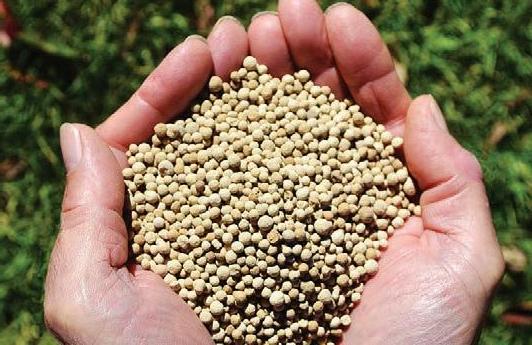
9 minute read
Covering the basics
This profile is part of a seven-part series from WorkSafe New Zealand sharing the health and safety approaches taken by the grand finalists of the 2021 FMG Young Farmer of the Year competition. For the next seven weeks we will be sharing a profile and short video about each of the finalists and how they incorporate health and safety into their work, from a dairy farm manager to an agribusiness banker.
TASMAN FMG Young Farmer of the Year grand finalist Roshean Woods comes to the Young Farmer competition from a different background to many of her fellow finalists – but that gives her a range of perspectives, both from having worked on a farm and visiting farms in the course of her work.
Roshean, a farm systems scientist with DairyNZ, grew up in Timaru and excelled at sciences. Her interest in the agricultural sector was sparked by a talk at her school by representatives from Lincoln University and DairyNZ outlining the opportunities for scientists in the industry.
She gained a Bachelor of Science degree from Lincoln, as a DairyNZ Scholar, majoring in environmental bio-geoscience and plant science, followed by Honours focused on greenhouse gases, specifically nitrous oxide from soils and dairy effluent. She spent a year as a DairyNZ and AgResearch science intern and then returned to Lincoln to do her PhD researching how forages can reduce nitrate leaching in soils.
Along the way, she began to gain practical experience on farms.
Her first introduction was at Lincoln University’s research dairy farm, followed by a summer working at a commercial dairy farm.
During that time, she experienced a workplace accident when the two-wheeler she was riding hit a plank on a laneway and tipped her off. The experience has made her very aware of the importance of good health and safety practices, including keeping work areas free of hazards – and wearing the right PPE.
“I’d been given basic training in how to use the bike and was wearing a helmet and not travelling very fast as I was very aware of being new to riding the bike,” Roshean said. “But hitting the plank still tipped me over and I burned my leg on the bike.
“Usually, I would have been wearing full overalls but it was a very hot day, so for the first time I was wearing shorts and a t-shirt to work – if I’d been fully covered, I might have been better protected. The rest of my summer working on the farm was spent with my leg bandaged, trying very hard to keep it clean. The scars are fading now, but it’s a permanent reminder.”
After completing her doctorate, Roshean joined a farm environment consultancy in Canterbury, before moving to her current role with DairyNZ 18 months ago. While studying, she had also joined Christchurch City Young Farmers.
“They were very welcoming and a lot of my introduction to farm workplace health and safety has come through Young Farmers and the information provided by industry organisations,” she said.
“Also practical things at Young Farmers like how to get on and off a tractor, maintaining three points of contact.
“At the consultancy, I was doing a lot of farm systems modelling, which involved interacting with farmers to get a really good understanding of the farms and practices. Now, when I go out on farms I am mainly assisting our technical teams or meeting with farmers about our research projects.
“We always get in touch with the farmer to let them know we are coming and to try and arrange to meet them when we arrive,” she said.
“A lot of farmers use farm health and safety apps now. Often there will be a sign at the gate with details of the app, so you can sign in and see details and even pictures of any risks.
“Apps can be useful but it’s important to use them properly, as part of a wider health and safety programme. You can’t just get an app and think that’s your health and safety sorted.”
She says that as risks on-farm can change very quickly, she also always likes to meet the farmer as well.
“At certain times of the year, farmers may need to tell us if there are bulls in paddocks with the cows.
“There may be earthworks in certain areas, we need to keep away from, or to be made aware if there are any hazards in the laneways and places we shouldn’t be driving,” she said.
“I think the key to effective health and safety on farms is to keep it simple. I recently attended a seminar Al McCone (sector lead agriculture for WorkSafe) ran for the New Zealand Institute of Primary Industry Management. It was really interesting. Good health and safety on-farm isn’t about doing a lot of paperwork. You don’t need to. It’s about having all the basics covered and communicating well.”
Roshean Woods Farm systems scientist
WAKE UP CALL: A workplace accident involving a two-wheeler has made Roshean Woods very aware of the importance of good health and safety practices on-farm.

Calciprill ®

leaves all other limes for dust!

Application rate guide (kg/ha)*
Soil type Topdressed Direct drilled 0.5 pH increase or air seeded
Sand/loamy sand 300 75 Sandy/silt loam 500 125 Clay/loamy clay 625 150 10-15% organic matter 750 175 +25% organic matter 1000 200 *Omya recommends you soil test recularly and seek advice from independent agricultural professionals A 2-6mm lime granule made in Waikato from fi nely ground high purity limestone. • Cost effective • Low in dust, easy to spread • Breaks down rapidly in moisture • Can be applied using your own equipment • 95% < 75 microns



Dairy not yet an MIQ priority
RSE workers are in but dairy farm staff are out in the Government’s latest announcement on managed isolation availability.
Five hundred spaces a fortnight will be allocated in managed isolation facilities over the next 10 months, many for skilled and critical workers to support our economic recovery, Covid-19 Response Minister Chris Hipkins and Agriculture Minister Damien O’Connor say.
“The trans-Tasman bubble has freed up more rooms, allowing us to allocate more places in managed isolation for critical workers,” Hipkins says.
“It has given us flexibility to expand our engagement with the rest of the world on a targeted basis and attract skills and people needed to drive our economic recovery, while carefully managing risks of bringing in covid-19.”
About 500 MIQs rooms will be made available for “large groups” every fortnight. These include spaces for: • Around 300 RSE workers every month from June – with a total of 2400 arriving by March 2022; • 300 specialised construction workers between June and
October; • 400 international students for arrival in June, out of the 1000 previously; announced, for the start of semester two; • 100 refugees every six weeks from July.
O’Connor says the dedicated spaces in MIQ and renewed border exceptions will provide our agriculture, horticulture and viticulture sectors with the additional workforce to support our rural communities and help drive New Zealand’s economic recovery from covid-19.
“The Government and food and fibre sector have been working hard to mitigate worker shortages by training and upskilling New Zealanders, but there is still the need for additional labour,” O’Connor said.
“This decision should see around 2400 more RSE workers entering New Zealand in time for next summer’s harvest season and pruning this winter. This is in addition to the 7300 RSE workers currently in the country, including the 2000 the Government-approved to support the horticulture and viticulture industries during the recent summer harvest season.
“Border class exceptions have also been agreed for 40 more shearers and 125 rural mobile plant machinery operators for the 2021-22 season – subject to completion of sector workforce plans, a model to upskill New Zealanders and agreed wage rates,” he says.
The horticulture industry has welcomed the move.
“Pacific workers are an integral part of the horticulture industry’s seasonal workforce, particularly for harvest and winter pruning. They make up the shortfall in New Zealanders while at the same time, enabling the horticulture industry to grow and employ more New Zealanders in permanent positions,’ HortNZ chief executive Mike Chapman says.
“Indeed, over the past decade, the New Zealand horticulture industry has grown by 64% to $6.49 billion while in 2019, before covid struck, more than $40 million was returned to Pacific economies through the RSE scheme.”
Farming leaders, though, are disappointed there’s no room for the workers dairy farmers require.
Federated Farmers believes the pressure some farming families are now under, due to a severe lack of people to work on farms, is already taking a toll on stress levels, wellbeing and health.
“Farmers have been telling us for well over a year there is a real shortage of suitable dairy staff,” Federated Farmers employment and immigration spokesperson Chris Lewis says.
“I am getting daily calls about the labour situation and many farmers don’t know what to do for the coming season.
“I’m a farmer, not a social worker and I don’t know what to tell these people. As every dairy farmer knows the cows will always get milked, the question is, at what cost?”
There are 1250 jobs advertised on the Farm Source website today, 100 more than in March.
“And while the unemployment rate continues to fall, it’s obvious to see where the pressure is going on in small rural communities,” he says.
SKILLED LABOUR SHORTAGE: Farming leaders are disappointed there’s no room for the workers dairy farmers require.

Damien O’Connor Agriculture Minister
ADVERTISEMENT
American-made Cooper Tires guaranteed to last
Remember when washing machines and refrigerators lasted a generation? And tyres used to last for years too? Things used to last back then. Now it seems things are made to wear out. The reason for this is that original tyres fi tted to new vehicles are made to the vehicle manufacturer’s price. The result may compromise on the tyres’ performance and life. Cooper tyres are better value Tyre companies making aftermarket tyres exclusively for vehicle owners like you are still providing performance and longer life. Drivers choosing quality American made aftermarket tyres are fi nding they are getting a lot more mileage and better value for money than original tyres.

Cooper Tires – making tyres last since 1920. In 1926, Ira. J. Cooper developed the “cooper Creed” which focused the company on providing “good merchandise, fair play and a square deal”. The vision of Ira. J. Cooper continues at Cooper Tires today. Cooper’s A/T3 LT is the perfect tyre for New Zealanders who use their vehicle for work, carrying weight and towing. Durable Tread Technology makes this the no. 1 all-terrain tyre for New Zealand’s harsh high chip and volcanic road surfaces.
Comparison of tread depths. Bridgestone
AT 693 (8.1mm), Cooper AT 3 LT (12.7mm)
Coopers tyres are only available at selected Cooper Tire dealers. Freephone 0800 453 418




